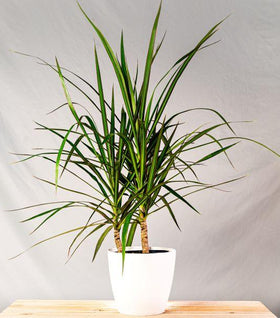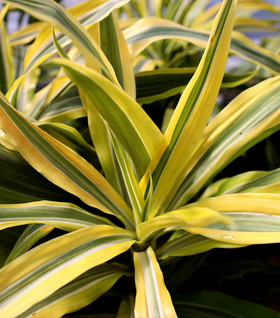Dracaena Plants for Sale Online
Dracaenas are among the easiest and most popular house plants sold today. Some people refer to this indoor plant as a corn plant due to its resemblance. Smaller Dracaena plants are perfect for use on a table, shelf or even as a desk Plant. As Dracaena plants age they will become quite large but they do remain slender and full.
They look great in corners or placed in front of bare walls in living rooms. Older Dracaenas can reach heights of up to 5 to 6 feet. Use the colorful foliage to add a bright splash to any room.
Boasting grassy blades of arching foliage, Dracaena plants are eye catching and fabulous plants for your home. They effortlessly bring a fun new element of design and flare to a space. The plants come in both tree and bush form, as well as in a wide variety of colors. The plants' versatility allows you to choose a Dracaena that's perfectly suited for your home.
Loved not only for their beauty and low maintenance care regimen, but also for their air cleaning abilities. Dracaenas are also one of the most effective houseplants for air purification, according to NASA Studies. They help remove formaldehyde, benzene, trichloroethylene, and carbon dioxide from the air in our homes or offices. View our complete offering of NASA clean air plants.
Dracaena plants are members of the asparagus family. Its foliage resembles the leaves of a cornstalk. As they grow, Dracaenas can lose their lower leaves until a rosette of foliage is held atop its cane-like stem.
Also nicknamed 'Mass Cane,' 'Corn Plants,' or 'Dragon Trees,' Dracaena Marginata can be grown outdoors if given the proper climate. But the plants have more readily become popular for use as indoor houseplants.
Across its native habitat in Africa, Dracaenas may grow to a height of more than 20 feet. Indoors you can expect it to reach a height of only 4 to 6 feet. Gardeners in zones 10 through 12 can grow dracaena plants outdoors year-round. However, gardeners in northern zones can only enjoy it as a houseplant.
Popular Types of Dracaena Plants:
- Dracaena marginata: Often called Madagascar Dragon Trees. They are a distinctive, tall houseplant that is an excellent choice for first-time houseplant buyers. They easily handle missed watering and minimal light without consequence.
- Lemon Lime Dracaena: This dracaena is truly an eye-catcher. Dracaena Lemon Lime features chartreuse leaves with gray-green centers and white stripes.
- Song of India Dracaena: These plants are beloved for their arching foliage that radiates bright shades of yellow and green. These spunky little trees make a fun bold addition to any space
- Limelight Dracaena: These carefree houseplants can be used to add height, drama, and a bright splash of color to any interior area. This is a relatively low-maintenance houseplant that will require only occasional pruning to remove old foliage.
- Janet Craig Dracaena: Dracaena Janet Craig plants are a lush, houseplant that cleans the air indoors. The dark green leaves are broad and arch slightly, creating a very graceful form. Grows well in Low Light areas of your home where few other houseplants will grow.
- Compact Janet Craig Dracaena: Dracaena Janet Craig Compacta is a dwarf form of the Janet Craig Dracaena. Grows Equally as well in low light areas as its bigger sister does. The compact version is perfect as a tabletop plant or on your desk at work.
- Dracaena marginata Kiwi: Dracaena marginata kiwi is an attractive, stiff-leaved plant with colorful foliage. This plant is sometimes referenced as the 'Kiwi Dragon Tree.'
Tips for Growing Dracaenas:
Lighting, Soil and Water:
Ideal plant care for a Dracaena would include medium to bright indirect light and water moderately. Dracaena houseplants are highly adaptable though, and will also learn to tolerate low light levels and periods of drought once established. These popular indoor plants will also grow under fluorescent light, making them the perfect office plant.
When it comes to watering your Dracaena plants, we recommend watering when the top of the soil has dried. Additionally, it is best to water your plant with a distilled or purified water. The minerals in tap water can be a bit too harsh for these tropical plants.
To protect your plant from root rot, plant your Dracaena in a well draining potting soil. Your plant will also benefit from a pot that has a drainage hole. All in all, Dracaena are hardy and easy-to-care-for plants to grow.
Fertilizer:
Dracaena plants do not have a high fertility requirement. Granular fertilizer such as Osmocote Plus can be sprinkled onto the soil surface twice per year in early spring and summer.
We suggest mixing Jack's classic houseplant fertilizer with water. This will provide your dracaenas with an even amount of nutrients without overfeeding them. Fertilizer should only be added to the water during the spring, summer, and early fall.
If you notice the tips of your dracaena leaves starting to turn brown, it's likely the plant is not getting enough humidity. This is easily remedied by misting the plant occasionally with clean lukewarm water from a regular household spray bottle.
Frequently Asked Questions About Dracaena:
Do Dracaena Plants Clean The Air?
Yes. According to the NASA Clean Air Study, Dracaena is one of the most efficient plants at removing toxins for the air. Dracaena remove formaldehyde from the air in your home, as well as other VOCs, including benzene, trichloroethylene, and xylene.
Are Dracaena Marginata Plants Pet Safe?
Keep your pets away from this plant, as it can be toxic to animals when ingested. View our collection of Pet Safe plants for non-toxic alternatives.





